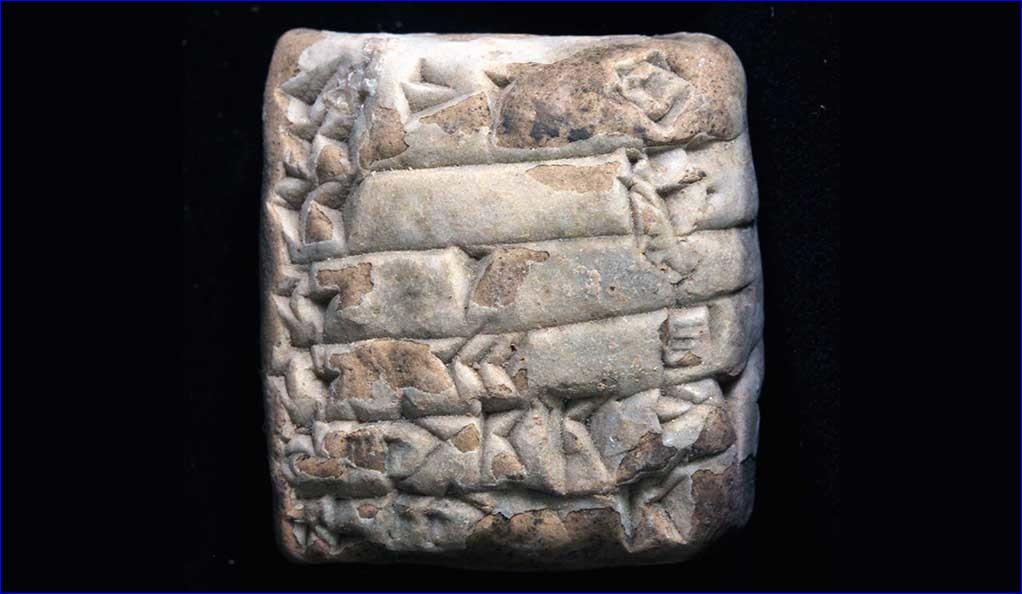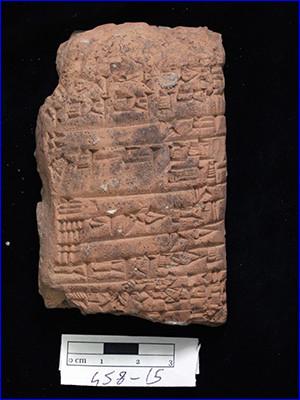


 Yale News)
Yale News)
Frahm, who is one of only a few hundred people worldwide who can accurately read cuneiform texts, was taken to an undisclosed location in the city, where he had about two and half days to study these texts in a warehouse in which they were being temporarily stored. Each tablet was about the size of a cell phone, and many were in a poor condition, with salt incrustations covering large portions of their surfaces.
"It seems likely that many of these tablets come from the same archive, which must have fallen prey to destruction at some point in time, with the tablets falling on the ground with one side exposed to water and the other protected," notes Frahm.
"It was a conveyer belt-like experience," says Frahm. "I had about three or four minutes to examine each tablet, and some were more difficult than others to decipher. On each tablet there may be a great secret that you might uncover if you spent the time with it."
The tablets were still in the original packages in which they had been sent to the U.S., where they were seized by customs officials before they made it to their intended destination. "They had been declared as being ceramic tiles valued at $300. This is how customs officials determined that something was not quite right," says Frahm.
One of the challenges of deciphering these tablets, says Frahm, is that the cuneiform writing system, which comprises about 900 signs, is very complex, and "each of these signs has many different possible readings depending on the context and on the time the tablet was written."
Frahm was able to establish fundamental facts about the tablets, including -- with the exception of a small few -- their authenticity and place of origin: southern Iraq. The bulk of the tablets, says Frahm, date back to the Ur III (2100--2000 BCE) and Old Babylonian (2000--1600 BCE) periods, and are mainly administrative and legal documents -- akin, says Frahm, "to today's emails or receipts. I was fundamentally trying to categorize these tablets along chronological lines."

 Yale News)
Yale News)
A collection of incantations from ca. 2,500 BCE is among the most important of these tablets, notes Frahm. "It invokes the gods An, Enlil, and Enki and asks for divine support for the restoration of a city. Only very few comparable pieces are known. There are some remarkable sign lists used in Old Babylonian schools, as well as private letters and contracts from this period. A bilingual first millennium BCE text is also interesting; it is written in Babylonian and in Emesal, a dialect of Sumerian (in fact, originally a women's language) used in the cult."
Frahm explains that many of the Ur III tablets originated from the ancient city of Irisagrig, which is situated on or along the ancient course of the Tigris River. The process of identifying tablets from Irisagrig began back in 2003, when significant numbers of looted administrative texts from the Ur III period were confiscated by Jordanian border officials, shortly after the American invasion of Iraq had come to a close.
"Beginning in 2004, other such tablets appeared on the market, on eBay and elsewhere. Scholars systematically collected all the available information on the tablets and established in the following years that they had many things in common and seemed to originate from a Sumerian city named Irisagrig, which was known from documents from other Mesopotamian sites," says Frahm.
"The new texts from Irisagrig cast some fascinating light on what is, quite literally, a 'lost city,'"says Frahm, "and help us reconstruct the social and economic life in a 4,000-year-old Mesopotamian settlement. Among the most exciting tablets from the lot inspected by me is a large document that records allocations of sustenance plots to royal dependents, and another that records food distributed to the 'dogs of the palace,' who were apparently well fed. Even small expenditures such as the disbursement of waterskins were faithfully recorded."
Several tablets deal with the issuing of rations to palace personnel such as female weavers, notes Frahm, while others record food allocations for royal envoys and other officials, and describe their missions, which include inspecting work on a canal and improving the royal road house, which is a place where people would rest while travelling along a royal road on their way to another city.
Frahm says that these tablets shed light on intriguing similarities between the ancient civilizations that produced them and us, including things such as governmental economic planning, taxation, long distance trade, and credit, "all of these very familiar concepts which we take for granted today that can be traced back to that time. They are first recorded in this very elaborate way in ancient Mesopotamia."
These tablets were not properly excavated and the archaeological context has been lost, but there is nonetheless an enormous amount of information that is encoded in these tablets and can be gleaned from them, says Frahm.
"It is extremely regrettable that this looting takes place. It destroys context, and we are losing vast amounts of information. When we actually find these tablets in context we can really establish exact archives," says Frahm. Yet at the same time, he says, he does not believe that, without that archaeological context, all information is lost and these objects are worthless and their contents should not be published.
The deciphering of these tablets took some detective work, says Frahm. "I found the level of detail of these tablets quite fascinating. This was something new to me, and it was interesting to learn about this lost city which has only been identified in the past few years."
"I would obviously prefer to do that on properly excavated tablets but when you are the first person after some 4,000 years to look at an ancient text in a meaningful way it is always very exciting," says Frahm.
Together with some 200 additional tablets that Frahm did not see, plus a substantial number of clay bullae and cylinder seals, the tablets were returned to the Republic of Iraq in a repatriation ceremony on May 2 at the residence of the Iraqi ambassador in Washington, D.C. Frahm doesn't know whether they have already been sent back to Iraq. Frahm says he hopes that the information encoded in the texts be soon made public for further scholarly research, and then be used for the reconstruction of the history and culture of ancient Mesopotamia.

or register to post a comment.